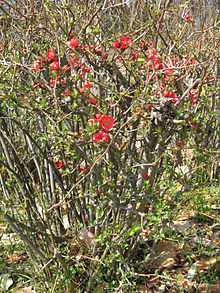Chaenomeles speciosa
| Chaenomeles speciosa | |
|---|---|
 | |
| Flowers of C. speciosa | |
| Scientific classification | |
| Kingdom: | Plantae |
| (unranked): | Angiosperms |
| (unranked): | Eudicots |
| (unranked): | Rosids |
| Order: | Rosales |
| Family: | Rosaceae |
| Genus: | Chaenomeles |
| Species: | C. speciosa |
| Binomial name | |
| Chaenomeles speciosa (Sweet) Nak. | |
| Synonyms[1] | |
| |
Chaenomeles speciosa (commonly known as flowering quince or Japanese quince[2] or as mugua[citation needed] in traditional Chinese medicine[3]) is a thorny deciduous or semi-evergreen shrub native to eastern Asia. It is taller than another commonly cultivated species, C. japonica, usually growing to about 2 m (6 ft 7 in).[2] The flowers are usually red, but may be white or pink, and the fruit is a fragrant but hard pome that resembles a quince.[2]
Cultivation
This plant is widely cultivated in temperate regions for its twining habit and its showy flowers which appear early in the season - occasionally even in midwinter. It is frequently used as an informal low hedge. Numerous cultivars with flowers in shades of white, pink and red have been selected. The following cultivars and hybrids have gained the Royal Horticultural Society's Award of Garden Merit:-
Ethnomedical uses
The fruit has been part of traditional Chinese medicine (TCM) for thousands of years, used to treat arthritis, leg edema, and cramping in the calf muscle.
Pharmacology
A constituent of its extract has been found to be an effective and selective dopamine reuptake inhibitor.[10]
See also
- Pseudocydonia (Chaenomeles sinensis), also called mugua
- Papaya, a tropical fruit that shares the name mugua
References and external links
- ↑ "The Plant List: A Working List of All Plant Species".
- ↑ 2.0 2.1 2.2 Bailey, L.H.; Bailey, E.Z.; the staff of the Liberty Hyde Bailey Hortorium. 1976. Hortus third: A concise dictionary of plants cultivated in the United States and Canada. Macmillan, New York.
- ↑ Subhuti Dharmananda 2005. "Chaenomeles: A relaxing and strengthening fruit" in Institute for Traditional Medicine database
- ↑ http://apps.rhs.org.uk/plantselector/plant?plantid=376
- ↑ http://apps.rhs.org.uk/plantselector/plant?plantid=377
- ↑ http://apps.rhs.org.uk/plantselector/plant?plantid=378
- ↑ http://apps.rhs.org.uk/plantselector/plant?plantid=379
- ↑ http://apps.rhs.org.uk/plantselector/plant?plantid=2304
- ↑ http://apps.rhs.org.uk/plantselector/plant?plantid=2305
- ↑ Zhao G, Jiang ZH, Zheng XW, Zang SY, Guo LH (2008). "Dopamine transporter inhibitory and antiparkinsonian effect of common flowering quince extract.". Pharmacol Biochem Behav 90 (3): 363–71. doi:10.1016/j.pbb.2008.03.014. PMID 18485464.
- article Effects and mechanisms of glucosides of chaenomeles speciosa on collagen-induced arthritis in rats
- Information from USDA PLANTS
- Information from Plants for a Future
- Information from Chinese Medicine Basics
- article Glucosides of Chaenomeles speciosa remit rat adjuvant arthritis by inhibiting synoviocyte activities
| Wikimedia Commons has media related to Chaenomeles speciosa. |